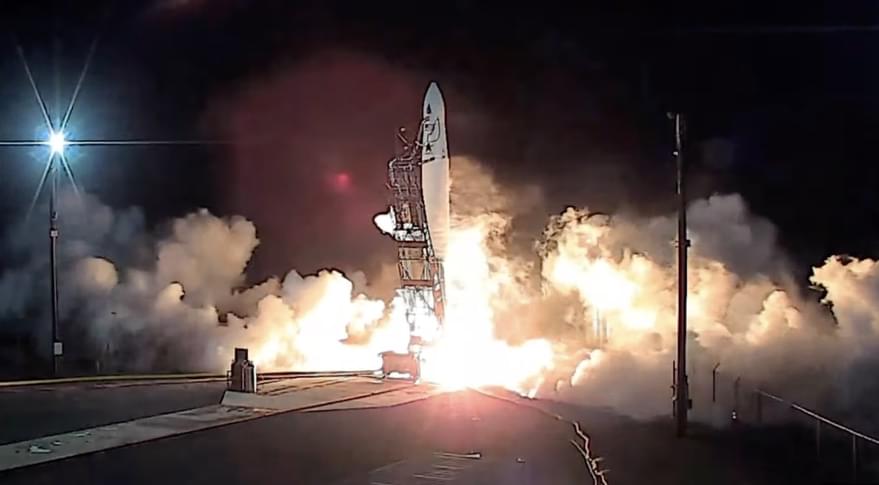Source: SpaceNews Date Published: 11/20/2021.
Astra Space’s Rocket 3.3 successfully reached orbit on a Nov. 20 launch, the fourth orbital launch attempt by the small launch vehicle startup.



The new Tesla Model P phone is coming. The best news for Tesla fans.
Designer Antonio De Rose and his ADR Studio Design lab released a clone of the Tesla Phone. It’s fun to show off ADR’s continued design skills.
Rumors are surfacing that Tesla really is planning to make a smartphone. Already, ADR’s concept images are looking a whole lot cooler. Especially for the Tesla fans.

Claim your SPECIAL OFFER for MagellanTV here: https://try.magellantv.com/historyoftheuniverse. Start your free trial TODAY so you can watch Solar Superstorms 4K, and the rest of MagellanTV’s science collection: https://www.magellantv.com/video/solar-superstorms-4k.
Researched and Written by JD Voyek.
Narrated and Edited by David Kelly.
Thumbnail Art by Ettore Mazza.
REFERENCES:
https://www.britannica.com/biography/Santorio-Santorio.
https://www.sciencehistory.org/distillations/probing-the-mys…-digestion.
https://www.theguardian.com/science/2009/apr/02/paul-dirac-s…lo-quantum.
https://www.nobelprize.org/prizes/physics/1933/dirac/biographical/
https://home.cern/science/physics/cosmic-rays-particles-outer-space.
https://timeline.web.cern.ch/charles-thomson-rees-wilson-sees-particle-tracks.
https://www.nobelprize.org/prizes/physics/1935/chadwick/biographical/
https://history.lbl.gov/1950s/
https://www.nobelprize.org/prizes/physics/1959/ceremony-speech.
https://www.forbes.com/sites/startswithabang/2018/01/27/ask-…antimatter.
https://home.cern/news/news/experiments/alpha-observes-light…first-time.
https://www.ncbi.nlm.nih.gov/pmc/articles/PMC3653214/
https://www.doemedicalsciences.org/historypetmri.shtml.
https://www.nature.com/articles/d41586-019-01895-z.
https://www.theguardian.com/science/2019/aug/10/most-importa…ed-science.
https://www.aps.org/publications/apsnews/200803/physicshistory.cfm.
https://www.nasa.gov/centers/goddard/news/topstory/2007/antimatter_binary.html.
https://www.forbes.com/sites/briankoberlein/2016/12/27/could…6b1ab340e6
https://particleadventure.org/images/history-universe-2013.jpg.
https://www.nps.gov/people/dr-chien-shiung-wu-the-first-lady-of-physics.htm.
https://www.aps.org/publications/apsnews/200306/csb.cfm.
https://cerncourier.com/a/cp-violations-early-days/
https://home.cern/news/news/physics/fifty-years-cp-violation.
https://www.science.org/news/2017/04/giant-space-magnet-may-…antimatter.
Music from Silver Maple, Epidemic Sound and Artlist.
Stock footage from Videoblocks, images of galaxies and black holes from NASA Goddard Visualization Studio.
PBS Member Stations rely on viewers like you. To support your local station, go to: http://to.pbs.org/DonateSPACE
↓ More info below ↓
Sign Up on Patreon to get access to the Space Time Discord!
https://www.patreon.com/pbsspacetime.
Check out the Space Time Merch Store.
https://pbsspacetime.com/
Sign up for the mailing list to get episode notifications and hear special announcements!
https://tinyurl.com/yx9cusk5
From Stargate to Interstellar, wormholes are our favorite method for traveling across fictional universes. But they are also a very serious field of study for some of our greatest minds over the last century. So what’s the holdup? When do we get to wormhole ourselves out of here?
Hosted by Matt O’Dowd.
Viewers like you help make PBS (Thank you 😃). Support your local PBS Member Station here: https://to.pbs.org/DonateSPACE
Find out how scientists are mapping the black holes throughout the Milky Way and beyond as well as the answer to the Escape the Kugelblitz Challenge Question. Were you able to save humanity?
Get your own Space Time tshirt at http://bit.ly/1QlzoBi.
Tweet at us! @pbsspacetime.
Facebook: facebook.com/pbsspacetime.
Email us! pbsspacetime [at] gmail [dot] com.
Comment on Reddit: http://www.reddit.com/r/pbsspacetime.
Help translate our videos! https://www.youtube.com/timedtext_cs_panel?tab=2&c=UC7_gcs09iThXybpVgjHZ_7g.
Quasars, X-ray Binaries and Supermassive voids at the center of our galaxies … black holes take many forms. In this episode Matt tells us what these different types of black holes are and how scientists are using VLBI, Very Long Baseline Interferometry, to map the different black holes throughout the known universe.
Resolving Microlensing Events with Triggered VLBI
To check out any of the lectures available from Great Courses Plus go to http://ow.ly/Y8lm303oKJe.
SXSW Panel Picker Sign-up: https://panelpicker.sxsw.com/vote/68148
Get your own Space Time tshirt at http://bit.ly/1QlzoBi.
Tweet at us! @pbsspacetime.
Facebook: facebook.com/pbsspacetime.
Email us! pbsspacetime [at] gmail [dot] com.
Comment on Reddit: http://www.reddit.com/r/pbsspacetime.
Support us on Patreon! http://www.patreon.com/pbsspacetime.
Help translate our videos! https://www.youtube.com/timedtext_cs_panel?tab=2&c=UC7_gcs09iThXybpVgjHZ_7g.
The Kepler telescope recently noticed a strange partial eclipse that some have speculated could be a Dyson Sphere. Are Dyson Sphere’s possible? Are they practical? What other alternatives to futuristic energy capture do we have to choose from? Why not a kugelblitz — a swarm of black hole powered engines?
Previous Episode.
Go to https://curiositystream.thld.co/NERD and use code NERD to save 25% off today, that’s only $14.99 a year. Thanks to Curiosity Stream for sponsoring today’s video. ~ In 1984 something strange happened in the village of Dodleston. A BBC Micro was sitting on a counter, when it suddenly started receiving mysterious messages, which appeared to come from the 16th century. This might have gone unnoticed had local teachers, Ken Webster and Peter Trinder, not investigated to find that information was so accurate, it would be almost impossible to fake. This whole event was documented in the book “The Vertical Plane”, published in 1989. But here, tonight, we investigate deep to find out exactly what this is all about.
Thank you to these excellent peeps. Please check out their channels;
Ashens: https://www.youtube.com/theproxy.
TristaBytes: https://www.youtube.com/c/TristaBytes.
WhatHoSnorkers: https://www.youtube.com/channel/UCmKA-MiHwHpuawrhPBsWzJg.
Octavius King: https://www.youtube.com/c/0ctav1usKitten.
Slope’s Game Room: https://www.youtube.com/c/djslopesroom.
Ponder: https://www.youtube.com/channel/UCeOCi7IAMOp1WpJhKUqc_cQ
0:00–01:10 Introduction.
01:10–02:05 Curiosity Stream.
02:05–29:15 The Dodleston Messages.
29:15–35:52 Post Events.
35:52–40:35 Dissection.
40:35–41:53 Further Reading.
41:53–43:01 Credits.
🔗Video Links🔗
Blogs:
Mercurius Politicus: http://mercuriuspoliticus.wordpress.com/2010/11/01/ghost-in-the-machine/
Contacting 2109: http://contacting2109.com/vertical-plane-ghost-machine/
Macy Afterlife: http://macyafterlife.com/2018/02/10/time-hopping-the-amazing…n-webster/
Time Slips: http://time-slips.blogspot.com/2011/08/wot-strange-wordes-thou-speke.html.
Skeptophilia: http://skeptophilia.com/2014/08/the-haunted-pc.html.
Tom Ruffles: http://tomruffles.wordpress.com/2020/08/14/the-vertical-plane-by-ken-webster/
Ley Lines: http://landandspirit.net/earth-energies/leylines/
Podcasts:
Unexplained Podcast: http://unexplainedpodcast.com/episodes/2018/7/25/s03-episode…-until-end.
Mysterious Universe: http://podcastaddict.com/episode/29862737
Dark Histories: http://darkhistories.com/the-dodleston-messages-ghost-in-the-machine/
Books:
Join us on Patreon!
https://www.patreon.com/MichaelLustgartenPhD
Papers referenced in the video:
Inter-and intraindividual variability in daily resting heart rate and its associations with age, sex, sleep, BMI, and time of year: Retrospective, longitudinal cohort study of 92,457 adults.
https://pubmed.ncbi.nlm.nih.gov/32023264/
Heart rate variability with photoplethysmography in 8 million individuals: a cross-sectional study.
https://pubmed.ncbi.nlm.nih.gov/33328029/